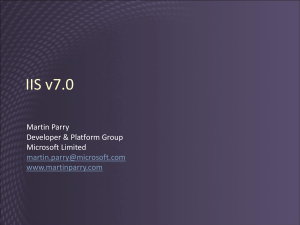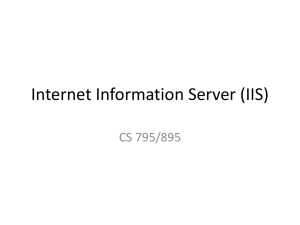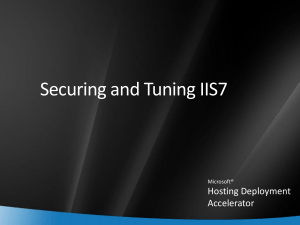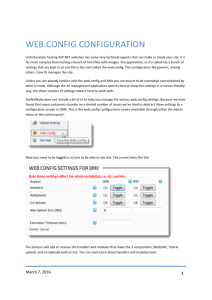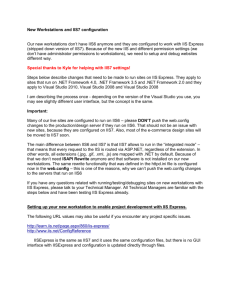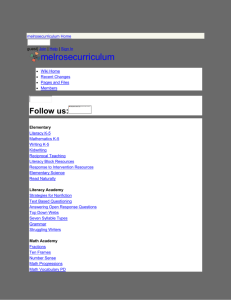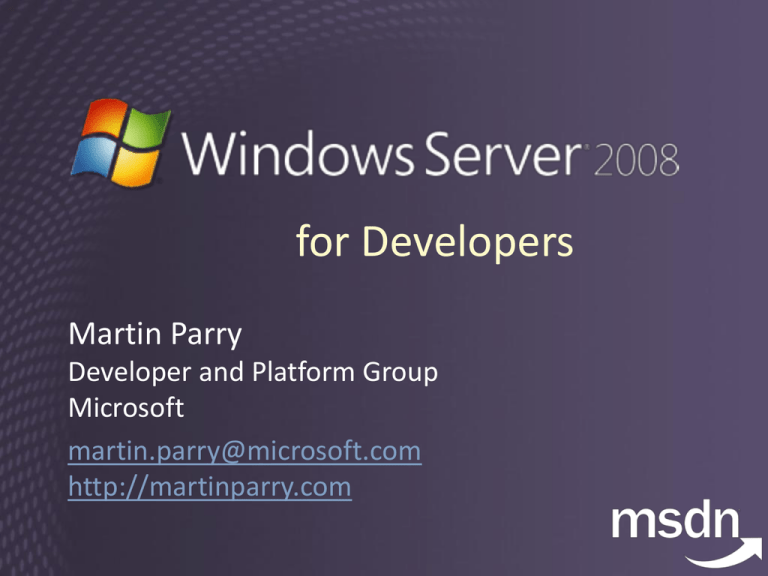
for Developers
Martin Parry
Developer and Platform Group
Microsoft
martin.parry@microsoft.com
http://martinparry.com
Agenda
Top 7 Ways To “Light Up” Your Apps on
Windows Server 2008
Part 1 emphasis on
IIS7, PowerShell
Part 2 emphasis on
WER, Restart and Recovery APIs, TxF
The Top 7 Ways… Part 1
1.
2.
3.
4.
5.
6.
7.
Build More Flexible Web Applications
Design Highly-Manageable Applications
Develop Federation-Aware Applications
Build Connected Systems
Build For Scalability
Virtualize
Develop More Reliable Applications
1. Build More Flexible Web Apps
IIS 7.0 Introduction
Client version shipped with Windows Vista
Limited throughput
Server version will ship with WS2008
Currently available in RC form
More features than client
IIS 6.0 Architecture
IIS 7.0 Architecture
Windows Process Activation Service
Manages configuration
What used to be the metabase
Responsible for starting worker processes...
w3wp.exe
...and routing incoming requests to the
appropriate worker process
Also hosts the new listener adapter interface
You can build your own listeners for WAS
IIS 6.0 Request Pipeline
IIS 6.0 Request Pipeline
IIS pipeline extensible using ISAPI
Native code
Can apply to all requests
ASP.NET pipeline extensible using IHttpModule
Managed code
Can only apply to requests routed via ASP.NET
Certain pipeline elements are “always there”
IIS authentication
Logging
IIS 7.0 Request Pipeline
IIS 7.0 Request Pipeline
Linear sequence of modules
Any module can be enabled/disabled
Including “built-in” ones
Modules can be managed or native code
Any type of module applies to any request
IIS7 Modules
IIS 6.0 Configuration
IIS 6.0 (and earlier) use the metabase
Stores all configuration information
Originally in binary form, then in XML
Hard to allow management of separate apps by
different groups of people
IIS 7.0 Configuration
machine.config
applicationHost.config
“root” web.config
web.config
web.config
web.config
IIS7 Configuration
Building Native Modules
Export a RegisterModule function from DLL
Define one or more other functions
To process request or response
Inside RegisterModule...
Hook up your other functions(s) at specific points
in the pipeline
E.g. Begin, AuthN, AuthZ, ExecuteHandler, End
Building Managed Modules
Implement IHttpModule
Implement Init function
Attach event handlers for specific points in the
pipeline
E.g. Begin, AuthN, AuthZ, ExecuteHandler, End
Same as existing ASP.NET HttpModules
IIS7 Managed Module
IIS7 Diagnostics - RSCA
Runtime Status and Control API
Shows currently executing: Application Pools
Requests
Exposed via
IIS admin tool
Programmatically via WMI and Managed OM
IIS7 Diagnostics – Failed Requests
IIS7 allows you to log trace information just
for requests that fail
For some definition of failure
Buffers all trace output
Only flushes to disk if the request fails
Log output is XML, with a stylesheet
Breaks down processing by module
Includes timing details for each module
IIS7 – Failed Request Tracing
Enable FREB at the Web Site level
Configure FREB rules at the application level
Each rule: Specifies the type of web content it applies to
Can specify a specific failure code
Can specify a duration in seconds
Can specify a trace event severity
IIS7 Failed Request Tracing
2. Design Highly-Manageable Apps
Management in Windows Server 2008
MMC v3.0
Managed framework for building snap-ins
Microsoft.ManagementConsole namespace
– Ships with .NET Framework v3.0
Already seen it in use – IIS Admin Console
Windows PowerShell
Windows PowerShell
It’s a command-line interface!
Scriptable
Commands may be composed
Not based on text, based on .NET objects
Available for...
Windows XP
Windows Server 2003
Windows Vista
Ships inside...
Windows Server 2008
Windows PowerShell and Scripting
PowerShell and Developers
Developers can create new commands
...and can create PowerShell “drives”
Excellent way to provide admin experience for
your applications.
Exchange 2007 and SQL Server 2008, for example
PowerShell Cmdlets and Providers
3. Develop Federation-Aware Apps
Developing Federated Identity Apps
With AD FS
Active Directory Federation Services
Why?
Enables cross-domain, cross-platform access to your
Web applications
Provides Web SSO experience
Promotes a claims-based programming model
Achieve reach for your application
– Think “outside of the firewall”
B2B Federation Scenario
A. Datum
Account Forest
Trey Research
Resource Forest
Federation Trust
Active Directory
Account
Federation Server
Resource
Federation Server
https
https
`
https
Internal Client
Web Server
Application Authorization Using Claims
Claims
Statements made by an authority about a user
Used for authorization purposes
Three types of ADFS claims
Identity
Identity
– Email
– User Principal Name (UPN)
– Common Name
Group
Custom
UPN:
eric@adatum.com
Group
Custom
Purchaser
Administrator
Adatum
DisplayName:
Eric Parkinson
Position:
Purchasing Staff
Coding a Federation-Aware app
System.Web.Security.SingleSignOn
System.Web.Security.SingleSignOn.Authorization
In code: SsoId = User.Identity as SingleSignOnIdentity
SsoId.IsAuthenticated – have we a good security token?
SsoId.SecurityPropertyCollection – each item could be...
– Group claim, UPN claim, custom claim
Application can get any/all claim details
4. Build Connected Systems
Windows Communication Foundation
ASMX
.NET Remoting
Interop
with other
platforms
Extensibility
Location transparency
AttributeBased
Programming
Enterprise
Services
WS-*
Protocol
Support
WSE
MessageOriented
Programming
System.Messaging
Poison Message
Handling
Sub-queues
MSMQ 4.0
App-Specific
Dead Letter Queues
Transactional
Remote Receive
Sub-queues
Never created explicitly
Accessed via DIRECT FormatName...
DIRECT=OS:server\private$\myqueue;mysubq
Created at time of first Open
Can receive in the normal fashion
Can only insert with MQMoveMessage
No managed code equivalent
Poison Message Handling
WCF binding configuration...
<netMsmqBinding>
<binding name="PoisonBinding"
receiveRetryCount="0“
maxRetryCycles="1“
retryCycleDelay="00:00:05“
receiveErrorHandling="Move">
</binding>
</netMsmqBinding>
End of Part One
Build More Flexible Web Applications
IIS7
Design Highly-Manageable Applications
Windows PowerShell, MMC3
Develop Federation-Aware Applications
AD FS
Build Connected Systems
WCF, MSMQ 4
MSDN in the UK
Visit http://msdn.co.uk
Newsletter
Events
Screencasts
Blogs
© 2007 Microsoft Ltd. All rights reserved. Microsoft, Windows, Windows Vista and other product names are or may be registered trademarks and/or trademarks in the U.S. and/or other countries.
The information herein is for informational purposes only and represents the current view of Microsoft Corporation as of the date of this presentation. Because Microsoft must respond to changing market
conditions, it should not be interpreted to be a commitment on the part of Microsoft, and Microsoft cannot guarantee the accuracy of any information provided after the date of this presentation.
MICROSOFT MAKES NO WARRANTIES, EXPRESS, IMPLIED OR STATUTORY, AS TO THE INFORMATION IN THIS PRESENTATION.


